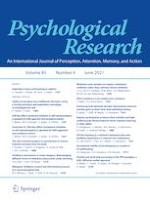11-04-2020 | Original Article
Is a letterbox always a letterbox? The role of affordances in guiding perceptual categorization
Gepubliceerd in: Psychological Research | Uitgave 4/2021
Log in om toegang te krijgenAbstract
Classically investigated in the context of judgment tasks about achievable actions, affordances have also been investigated in the context of the stimulus–response compatibility paradigm. Earlier work showed that perceptual categorization performance is significantly faster and more accurate when the orientation of the graspable part of a presented object, and the orientation of the participant’s response are compatible, suggesting that the main function of affordances is restricted to action preparation. Here, we investigate the potential role of affordances in the categorization of ambiguous stimuli through a stimulus–response compatibility paradigm. In other words, we investigate if in ambiguous situations, such as ones in which a stimulus may give rise to two percepts, affordances would stabilize perception on one of these two and, therefore, helps in the subsequent categorizations. Two experiments were run, based on the forced-choice stimulus–response compatibility (SRC) paradigm, with a progressive series of ambiguous (bistable) lateral-graspable objects. In Experiment 1, subjects responded by pressing horizontally opposite keyboard keys, while in Experiment 2, the keyboard keys were vertically separated. Experiment 1 found that subjects perceived the initial object in a bistable series for longer, and exhibited greater response stability in compatible than incompatible situations. In Experiment 2, none of these modulations were significant. Overall, our results show that affordances operationalized through a SRC paradigm modulated how subjects categorized ambiguous stimuli. We argue that affordances may play a substantial role in ambiguous contexts by reducing the uncertainty of such situations.
